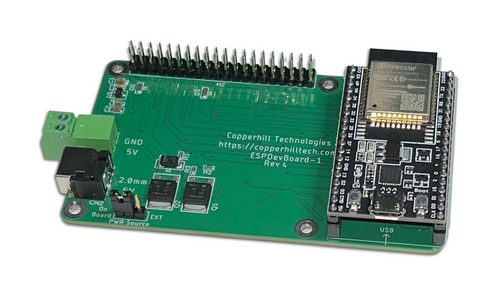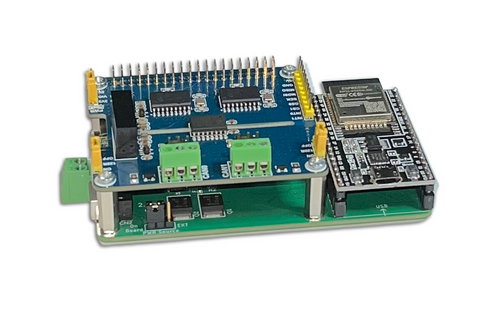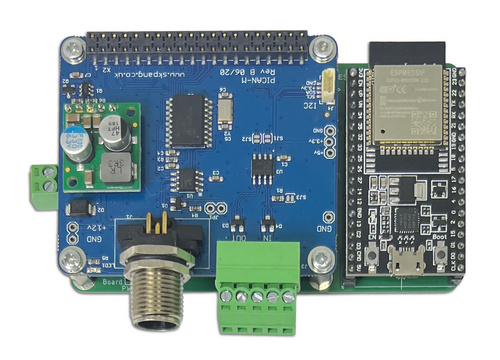Trending...
- xREnergy up as much as +3,094,634% on first day listed on the XRP Ledger. Ticker : $XRE
- The Tide Project Opens at Biennale Architettura 2025 in Venice Amplifying Youth Voices
- Bonelli Systems Expands Managed IT Services Nationwide, Leveraging Microsoft Azure Expertise
Copperhill Technologies, a provider of embedded systems for CAN Bus development, introduces the espBerry, a new line of ESP32 development boards. The espBerry series includes the basic espBerry board, a dual CAN-Bus channel system, and an NMEA 2000 & NMEA 0183 development board. Further configurations are in the works. Still, the espBerry concept supports engineers with the implementation of additional HATs. Open-source code samples support all hardware configurations.
GREENFIELD, Mass. - PennZone -- The espBerry DevBoard combines the ESP32-DevKitC development board with any Raspberry Pi HAT by connecting to the onboard RPi-compatible 40-pin GPIO header.
The purpose of the espBerry should not be perceived as a Raspberry Pi alternative but as extending the ESP32's functionality by tapping into the vast offerings of RPi HATs in the market and taking advantage of the multiple and flexible hardware options.
More on The PennZone
The espBerry project continues to integrate an ever-increasing number of existing RPi HATs and provide the corresponding software libraries free of charge. Furthermore, multiple open-source code samples exploit the popular Arduino IDE's excellent programming capabilities.
The espBerry Base Board utilizes the ESP32-DevKitC development board, which provides wireless connectivity per WiFi, Bluetooth, or BLE (Bluetooth Low Energy). Furthermore, the development module connects to the Raspberry Pi GPIO header per SPI, UART, and didgital I/O. This configuration opens the door to many possible applications, including IoT.
The espBerry with Dual Isolated Channel CAN Bus expansion HAT, designed for the Raspberry Pi, supports the full CAN2.0 Standard, and it features multi-onboard protection circuits, high anti-interference capability, and reliable operation. As a result, it suits applications such as automotive devices or industrial automation.
More on The PennZone
The HAT is well documented, and multiple code samples use the C programming language under the Arduino IDE.
The espBerry with PICAN-M (M = Marine) utilizes a Raspberry Pi HAT with NMEA 0183 and NMEA 2000 connection. The NMEA 0183 (RS422) port is accessible via a 5-way screw terminal. The NMEA 2000 port is accessible via a Micro-C connector.
The board comes with a 3A SMPS (Switch Mode Power Supply), allowing to power the Raspberry Pi plus HAT from an onboard power source (12 VDC).
The purpose of the espBerry should not be perceived as a Raspberry Pi alternative but as extending the ESP32's functionality by tapping into the vast offerings of RPi HATs in the market and taking advantage of the multiple and flexible hardware options.
More on The PennZone
- Exciting First Five Months Of 2025 At Aiatranslations
- Fairmint Introduces First Fully Onchain and Open Cap Table Infrastructure
- Vortex Brands Begins Gold Purchases Under New Joint Venture with Dubai-Based Partner
- Author Chandra Donelson Visits the Children's Museum of Pittsburgh
- Chandra Donelson Headlines the Hike2 Innovation Summit 2025
The espBerry project continues to integrate an ever-increasing number of existing RPi HATs and provide the corresponding software libraries free of charge. Furthermore, multiple open-source code samples exploit the popular Arduino IDE's excellent programming capabilities.
The espBerry Base Board utilizes the ESP32-DevKitC development board, which provides wireless connectivity per WiFi, Bluetooth, or BLE (Bluetooth Low Energy). Furthermore, the development module connects to the Raspberry Pi GPIO header per SPI, UART, and didgital I/O. This configuration opens the door to many possible applications, including IoT.
The espBerry with Dual Isolated Channel CAN Bus expansion HAT, designed for the Raspberry Pi, supports the full CAN2.0 Standard, and it features multi-onboard protection circuits, high anti-interference capability, and reliable operation. As a result, it suits applications such as automotive devices or industrial automation.
More on The PennZone
- NBA Champion Lamar Odom Launches Anti-Addiction Meme Coin, Ushering in a Disruptive Innovation in Web3
- Aureli Construction Sets the Standard for Seamless Home Additions in Greater Boston
- Actuated Medical Launches Participating Preferred Series A Round, Led by Keiretsu Forum Mid-Atlantic, South-East, & Texas
- ScreenPoints Puts Film Investors in the Credits—and in the Money With New FinTech Platform
- Viatris Announces Positive Top-Line Results from Two Pivotal Phase 3 Studies of Novel Fast-Acting Meloxicam (MR-107A-02) for the Treatment of Moderate-to-Severe Acute Pain
The HAT is well documented, and multiple code samples use the C programming language under the Arduino IDE.
The espBerry with PICAN-M (M = Marine) utilizes a Raspberry Pi HAT with NMEA 0183 and NMEA 2000 connection. The NMEA 0183 (RS422) port is accessible via a 5-way screw terminal. The NMEA 2000 port is accessible via a Micro-C connector.
The board comes with a 3A SMPS (Switch Mode Power Supply), allowing to power the Raspberry Pi plus HAT from an onboard power source (12 VDC).
Source: Copperhill Technologies Corp.
0 Comments
Latest on The PennZone
- Nurse leader Julie Nyhus has been named editorial director of American Nurse Journal
- ABM for Good™ Launches First Project with Build Change
- Braces for Teenagers in Allentown Offered by Exeter Smiles
- Roots for Boots to Host "Bike Day Bash" Featuring Trike Presentation to Local Veteran
- JOSHWAY Cuts Ribbon on New Brick-and-Mortar Location
- ImagineX, in Collaboration with Qualys, Launches New mROC Services to Transform Enterprise Cyber Risk Management
- Ditch Micromanagement: New Leadership Book for Results-Driven, Accountability-Based Teams
- Jay Tapp was named Managing Director in British Columbia
- Children's Hospital of Philadelphia Researchers Recommend New Standard of Care for Families with Hereditary Neuroblastoma Linked to ALK Mutation
- GormanSquared Announces Provisional Patent
- Hubei Heavy Equipment Makes a Striking Appearance at CIMT and Competes with International Brands
- 20 Patents Issued Worldwide, Cementing Company Leadership. First Ever Cable-Free 12-Lead ECG: HeartBeam, Inc. (Stock Symbol: BEAT)
- NASDAQ Uplisting for Higher Market Exposure and Wide Corporate Benefits to AI Boosted Marketing Company On Track Towards $1 Billion Revenue by 2027
- Congressional Men's Health Caucus Shows Bipartisan Consensus and Focus on Prevention, Mental Health, and Closing the Lifespan Gap
- Chewy Chums™ Launches NeverBite™ on Kickstarter
- DuoKey, Axiomtek and Blue Edge Network Partner to Enhance Smart Cities with Privacy-Preserving Urban Safeguarding and Fleet Management
- Fangzhou Launches Otsuka's Third-Generation Leukemia Drug Ponatinib on its Platform
- Viatris Announces Appointments of Frank D'Amelio and Michael Severino, M.D., to the Company's Board of Directors
- Austin Keen Joins WakeFX RopePal as Official Brand Ambassador
- Bonelli Systems Expands Managed IT Services Nationwide, Leveraging Microsoft Azure Expertise



